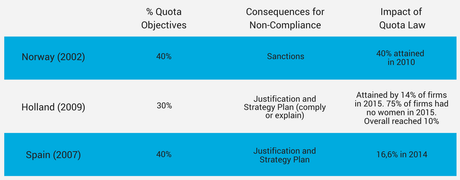With Stefan Gröschl
Every year, at the beginning of March, at ESSEC Business School are held the traditional Gender Equality Days*. This year was no exception to the rule. On that occasion, the ESSEC faculty community (through the Center of Excellence for Management & Society (CEMAS) Seminar) gathered to discuss gender equality-related research.
Diversity Quotas, Diverse Perspectives?
Junko Takagi, Chair of Leadership and Diversity, gave us a sneak peak of the book she co-wrote with her colleague Stefan Gröschl, Diversity Quotas, Diverse Perspectives. The book explores the application of quotas and affirmative action at an institutional and organizational level revealing the complex nature of policies in different countries. It focuses particularly on gender-related initiatives.
The Phenomenon of Underrepresentation in Upper-Level Management
It is irrefutable that women are underrepresented in upper-level management despite various attempts to address the issue through education and laws. In that context, quotas for corporate boards have been used as a legal means to narrow the gender equality gap in several countries, notably in Norway, Holland, Spain and France. In her presentation, Junko reminds us that the quotas are not reserved for women; they also apply to men meaning that this is not a women’s issue, but a gender issue.
Norway, an egalitarian society?
In 2002, Norway was the first country to launch gender quotas for corporate boards. You could argue it is obvious since Scandinavian countries pride themselves as being some of the most egalitarian societies. Yet, and you would be surprised, the lawmakers’ initiative was based on worrisome statistics: between 1992 and 2002, the percentage of women on corporate boards was stagnant and had remained at around 7%.
Their answer was clear. The government set a 40% gender quota for boardrooms in 2002 and introduced tough sanctions for companies that failed to implement the quota. Eight years later, the goal was reached.
Setting the Example
Many countries followed Norway’s initiative. Holland set a 30% and Spain a 40% gender quota for corporate boards. What is interesting to look at is not the percentage itself, but the consequences for non-compliant companies. In both countries, non-compliant companies needed to justify why they had not met the quota and come up with a strategy, the legal framework being less restrictive than Norway’s. The results were barely satisfactory; in Holland, only 14% of firms met the quota while 75% of firms had no women at all on their boards. The same thing happened in Spain in 2014; only 16.6% of the companies had met the 40% quota. These examples show the importance of sanctions in the implementation and success of gender quotas.

Beyond Figures
An important question that we should be asking ourselves is “What do these numbers mean and how are they to be interpreted?” Studies that have been conducted on the contribution of women directors on corporate boards have given contradictory results. Some studies conclude that women have made positive contributions, while others conclude that negative or no contributions were made. It is true, however, that firms that work on gender issues seem to be more sustainable over time.
Norway did set a great example for other European countries, and there is no doubt that quota legislation contributed to culture change in the workplace despite the restrictive legal framework. Hence, many countries, such as Holland, Spain, but also France, are now implementing quota legislation that will ultimately reduce if not eliminate the gender equality gap.
*To watch the full video, click here.









